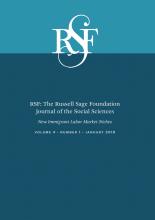Research Article
Open Access
Bridging the Service Divide: Dual Labor Niches and Embedded Opportunities in Restaurant Work
Eli R. Wilson
RSF: The Russell Sage Foundation Journal of the Social Sciences January 2018, 4 (1) 115-127; DOI: https://doi.org/10.7758/RSF.2018.4.1.07
Eli R. Wilson
aPhD from the University of California–Los Angeles and is visiting scholar at UCLA's Institute for Research on Labor and Employment

REFERENCES
- ↵
- Agius Vallejo, Jody
- ↵
- Bailey, Thomas, and
- Roger Waldinger
- ↵
- Barret, Rusty
- ↵Besen-Cassino, Yasemin. 2014. Consuming Work: Youth Labor in America. Philadelphia: Temple University Press.
- ↵Bourdain, Anthony. 2000. Kitchen Confidential: Adventures in the Culinary Underbelly. New York: HarperCollins.
- ↵Burawoy, Michael. 1979. Manufacturing Consent: Changes in the Labor Process Under Monopoly Capitalism. Chicago: University of Chicago Press.
- ↵Burt, Ronald S. 2005. Brokerage and Closure: An Introduction to Social Capital. Oxford: Oxford University Press.
- ↵
- ↵Ehrenreich, Barbara. 2001. Nickel and Dimed: On (Not) Getting By in America. New York: Henry Holt & Co.
- ↵Fine, Gary A. 1996. Kitchens: The Culture of Restaurant Work. Berkeley: University of California Press.
- ↵
- Gatta, Mary,
- Heather Boushey, , and
- Eileen Appelbaum
- ↵Glaser, Barney G., and Anselm L. Strauss. 1967. The Discovery of Grounded Theory. New York: Aldine.
- ↵Gomberg-Muñoz, Ruth. 2011. Labor and Legality: An Ethnography of a Mexican Immigrant Network. New York: Oxford University Press.
- ↵
- ↵Granovetter, Mark. 1995. Getting a Job: A Study of Contacts and Careers. 2nd ed. Chicago: University of Chicago Press. (Originally published in 1974.)
- ↵
- Hagan, Jacqueline Maria
- ↵Hagan, Jacqueline, Rubén Hernández-León, and Jean-Luc Demonsant. 2015. Skills of the Unskilled: Work and Mobility Among Mexican Migrants. Berkeley: University of California Press.
- ↵
- ↵
- ↵Hochschild Arlie. 1983. The Managed Heart: Commercialization of Human Feeling. Berkeley: University of California Press.
- ↵Hondagneu-Sotelo, Pierette. 2001. Doméstica: Immigrant Workers Cleaning and Caring in the Shadows of Affluence. Berkeley: University of California Press.
- ↵Jayaraman, Saru. 2014. Behind the Kitchen Door. Ithaca, N.Y.: Cornell University Press.
- ↵Kalleberg, Arne. 2011. Good Jobs, Bad Jobs: The Rise of Polarized and Precarious Employment Systems in the United States, 1970s–2000s. New York: Russell Sage Foundation.
- ↵Kanter, Rosabeth Moss. 1977. Men and Women of the Corporation. New York: Basic Books.
- ↵
- Lee, Jennifer
- ↵Leidner, Robin. 1993. Fast Food, Fast Talk: Service Work and the Routinization of Everyday Life. Berkeley: University of California Press.
- ↵
- Lopez, Steven
- ↵
- ↵Massey, Doug, Jorge Durand, and Nolan Malone. 2002. Beyond Smoke and Mirrors: Mexican Immigration in an Era of Economic Integration. New York: Russell Sage Foundation.
- ↵
- Morando, Sarah J
- ↵Moss, Philip, and Chris Tilly. 2001. Stories Employers Tell: Race, Skill, and Hiring in America. New York: Russell Sage Foundation.
- ↵Newman, Katherine. 1999. No Shame in My Game: The Working Poor in the Inner City. New York: Russell Sage Foundation.
- ↵
- Peri, Giovanni, and
- Chad Sparber
- ↵Portes, Alejandro, and Ruben Rumbaut. 2006. Immigrant America: A Portrait. 3rd ed. Berkeley: University of California Press.
- ↵Restaurant Opportunities Centers United (ROC). 2014. “The Great Service Divide: Occupational Segregation and Inequality in the U.S. Restaurant Industry.” New York: Restaurant Opportunities Centers United (October 22).
- ↵Restaurant Opportunities Center of Los Angeles (ROC-LA). 2011. Beyond the Kitchen Door. New York: Restaurant Opportunities Centers United (February 14).
- ↵
- Rivera, Laura
- ↵Sherman, Rachel. 2007. Class Acts; Service and Inequality in Luxury Hotels. Berkeley: University of California Press.
- ↵Telles, Edward, and Vilma Ortiz. 2008. Generations of Exclusion: Mexican-Americans, Assimilation, and Race. New York: Russell Sage Foundation.
- ↵
- Timmermans, Stefan, and
- Iddo Tavory
- ↵Waldinger, Roger, and Michael Lichter. 2003. How the Other Half Works: Immigration and the Social Organization of Labor. Berkeley: University of California Press.
- ↵
- Waldinger, Roger,
- Nelson Lim, , and
- David Cort
- ↵
- Warhurst, Chris, and
- Dennis Nickson
- ↵
- Warhurst, Chris, and
- Dennis Nickson
- ↵Whyte, William F. 1948. Human Relations in the Restaurant Industry. New York: McGraw-Hill.
- ↵
- Williams, Christine L., and
- Catherine Connell
- ↵Wilson, Eli R. 2017. “Stuck Behind Kitchen Doors? Assessing the Work Prospects of Latter-Generation Latino Workers in a Los Angeles Restaurant.” Unpublished paper. University of California, Los Angeles.
- ↵Zukin, Sharon. 1995. The Culture of Cities. Oxford: Blackwell.
In this issue
Bridging the Service Divide: Dual Labor Niches and Embedded Opportunities in Restaurant Work
Eli R. Wilson
RSF: The Russell Sage Foundation Journal of the Social Sciences Jan 2018, 4 (1) 115-127; DOI: 10.7758/RSF.2018.4.1.07
Jump to section
Related Articles
- No related articles found.
Cited By...
- No citing articles found.





